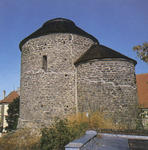
With 1,637 km
2 in area and a population of 133,948, the district of
Znojmo is one of Moravia's largest. Thanks to its southern border copying the boundary on Austria (which can be crossed at 6 official border crossings), the region is an important traveller's domain, also known for natural, historic, cultural and social attractions. Local economy is based on a mix of agriculture and industry. Major industries produce foodstuffs, ceramics, glass, and leather.
Agriculture specialises in cereals and leguminous plants, sugar beet and
the traditional vegetables, fruits, and vine. Farming traditions must of course reflect in local culture and social life: Znojmo Historic Vintage;
Znojmo Beer Festival; the Josephite Cost which is a wine exhibition for
vintners and wine-dealers from near and far; Znojemska Garden of Moravia; Martin's Feast; etc. Extensive nature reserves lie within Znojemsko's borders (the Podyji National Park; nature reserves Jevisovka, Rokytna, Zeletavka and central Pojihlavi) as well as a few small areas of natural beauty or cultural interest. Protected habitats are mostly steppes with thermopile flora and fauna and some minor remainders o f once vast inundation forests, swamps and waters with rare aquatic life.
A few pieces of the endangered bustard are still surviving in the district's southwest (the only occurrence in Czechia). The summer season offers several dams-Vranovska, Vyrovicka, Jevisovicka, to name a few-to enjoy swimming and water sports. Natural attractions concentrate in the Podyji National Park, with rare sceneries on a limited area. A web of hiking and biking paths that are linked with those on the Austrian side allow access into the national park. Here are some of the district's interesting places: Castles: Bitov;
Jevisovice; Znojmo. Chateaus: Vranov Nad Dyji; Moravsky Krumlov; Uhercice.
Castle ruins Cornstejn; Frejstejn; Novy Hradek; Templstejn; Lapikus; Simperk; etc. Technical monuments and museums: Water mill at Slup;
the SouthMoravian Museum in Znojmo. Galleries and exhibitions: Slavonic Epopee at the chateau of Moravsky Krumlov; House of Arts in Znojmo; Moravsky Krumlov's Museum and Gallery. Miscellaneous: Cellars and

tower of Znojmo Town Hall; some buildings of Znojmo's Urban Reserve, including some sacral monuments; the cross wine cellar at Primetice. Pilgrimage places: Hluboka Masuvka; Moravsky Krumlov; Miroslav; Znojmo-Hradiste etc.
The Znojmo area was settled as early as the paleolithic age, as has been proved by many archeological findings. It has been populated continuously since the sixth century, when the Slavs came to southern Moravia. The history of Znojmo is connected with the establishment of the old Slavic fortified settlement of St. Hippolyte in the ninth to tenth centuries, one of the major fortresses of Great Moravia. At the beginning of the eleventh century, after Great Moravia fell apart, the Znojmo princedom arose, in the form of a castle and a church - the Rotunda of the Virgin Mary. In 1226, the settlements joined together and King Premysl Otakar I elevated them to the status of a city.
In the middle ages, the old city area was set up, girded by ramparts, where it remains to this very day. Starting at the beginning of the thirteenth century, the city was home to the Minorite, Dominican, and Clare orders, and the Premonstrates had been settled in the Loutsky Monastery since 1190. Following a destructive fire in 1440, the city was rebuilt in the Renaissance style. In 1523, King Ludvik Jagellonsky confirmed Znojmo's status as a city, and the Pergamen Codex of the city's rights is now kept in the Znojmo archives. In 1628, after the battle of Bila Hora, a national congress was held, at which a Rennovated National Cosntitution for Moravia was adopted, which made it legal for the Habsburgs to
claim inherited rights to the Czech throne, and to reintroduce Catholicism and Germanization.
The city suffered substantial losses during the thirty-year war, as well as during the later Napoleonic wars. The city did not go through greater development until the eighteenth and nineteenth centuries, when imperial roads were built leading to Brno, Prague, and Vienna, and this development continued with the development of the ceramics and food industries.
At the present time, the city is a significant crossroads, where the food, footwear, ceramics, and engineering industries thrive. Thanks to the favorable climate, fruits, grapes, and cucumbers grow very well here. There are many landmarks, including
the Rotunda of the Virgin Mary and St. Katherine, the Znojmo Castle, the catacombs, the churches of St. Nicholas, St. Michael, and St. Kriz, St. Wenceslas's Chapel, the Loucky and Dominican Monasteries, the fortified settlement with the church of St. Hippolyte, and others. Due to its great value as a landmark, the historical center of Znojmo was named an urban landmark reservation in 1971.

 Guide
Guide 



